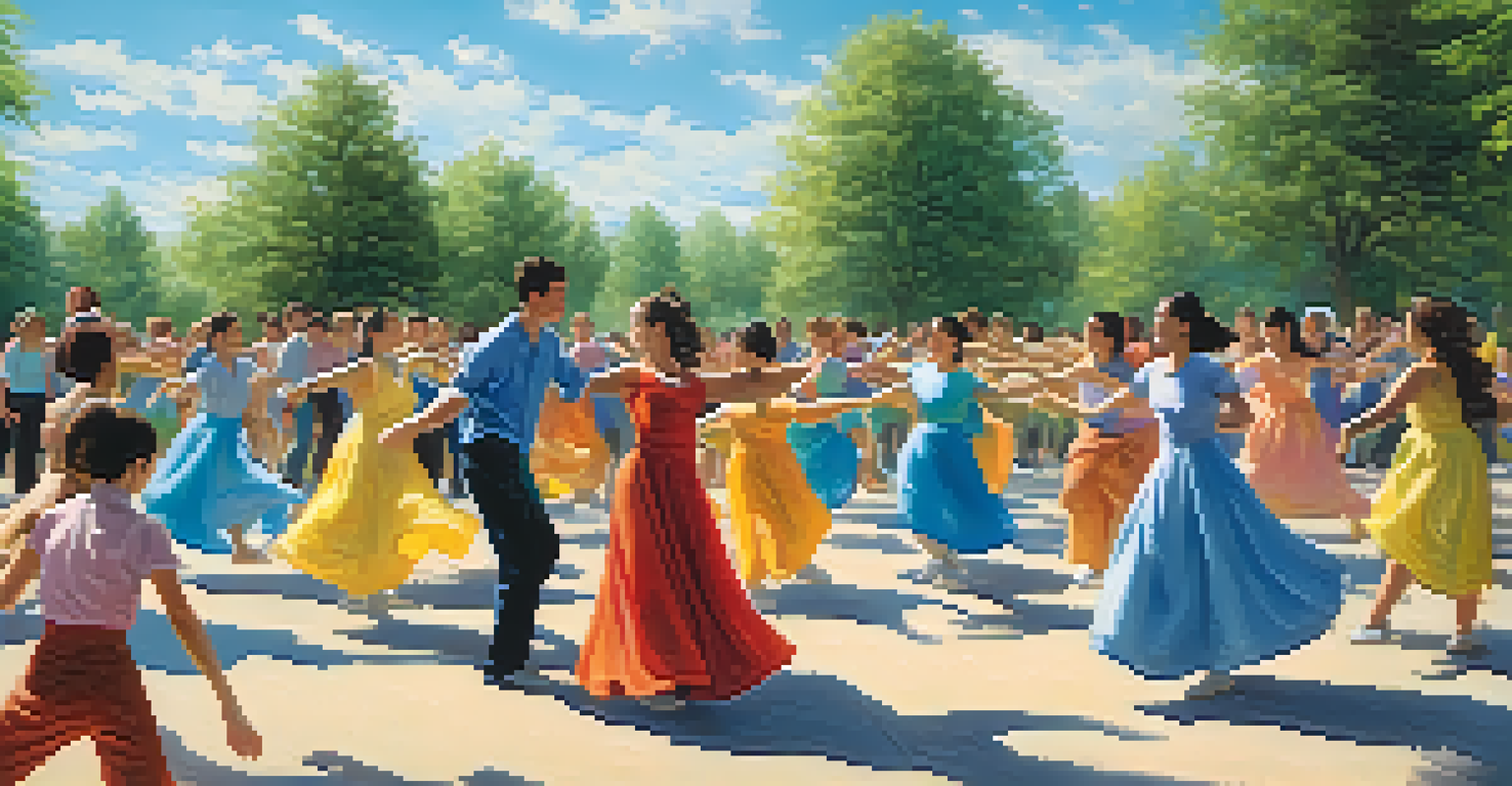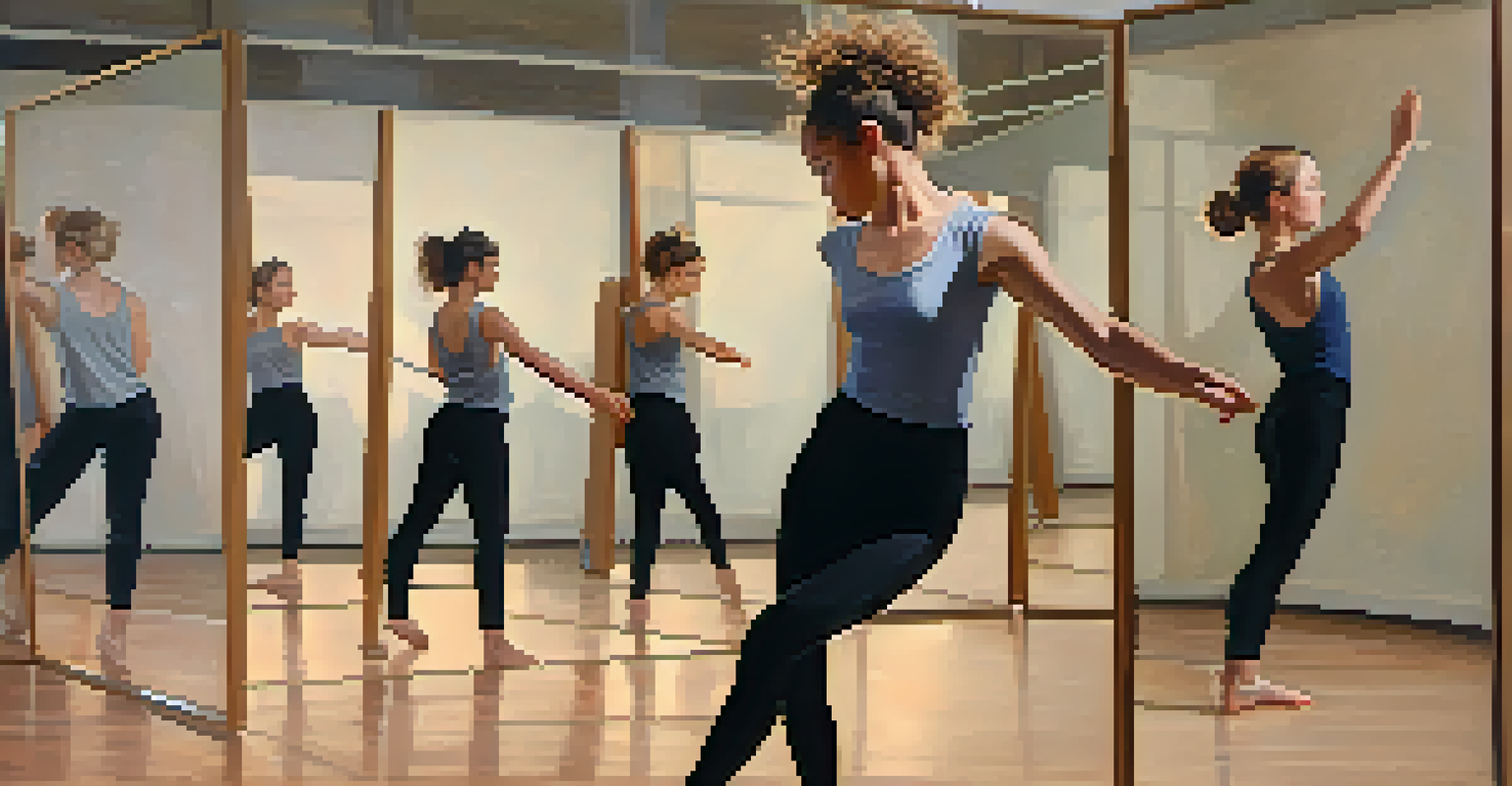Dance and Emotional Expression: A Key in Education

The Importance of Emotional Expression in Learning
Emotional expression plays a vital role in the learning process. When students can express their feelings, they engage more deeply with the material. This engagement can lead to better retention of information and a more enjoyable learning experience. In essence, emotions can fuel curiosity and creativity, paving the way for deeper understanding.
Dance is the hidden language of the soul.
Consider a classroom where students feel safe to share their emotions. This environment encourages open discussions and fosters a sense of community. When students feel connected, they are more likely to participate actively, leading to richer classroom dynamics. Emotional expression becomes a bridge, linking students' personal experiences to their academic journeys.
Furthermore, emotional expression is essential for developing social-emotional skills. These skills are necessary for navigating relationships and handling challenges in life. By integrating dance, educators can provide students with a creative outlet for their emotions, enhancing their overall emotional intelligence and resilience.
Dance as a Medium for Emotional Expression
Dance is a universal language that transcends barriers, allowing individuals to express emotions that words sometimes cannot capture. Through movement, students can convey joy, sadness, anger, and other complex feelings in a unique way. This form of expression can be particularly liberating, offering an alternative means of communication for those who struggle with verbal articulation.

For instance, a student who may feel overwhelmed by traditional academic pressures might find solace in dance. By participating in dance activities, they can channel their emotions constructively, leading to improved mental health. This liberation through movement can empower students, helping them to process their feelings and experiences more effectively.
Emotions Enhance Learning Engagement
Emotional expression fosters deeper engagement with learning materials, leading to better retention and a more enriching educational experience.
Moreover, dance encourages vulnerability, which is crucial for emotional growth. When students dance together, they often share personal stories and experiences, fostering empathy and understanding among peers. This shared journey through movement can strengthen bonds and cultivate a supportive classroom atmosphere.
Integrating Dance into Educational Curricula
Incorporating dance into educational curricula can transform the learning environment. By weaving movement into lessons, teachers can create dynamic experiences that cater to various learning styles. This approach not only enhances engagement but also allows for emotional exploration within academic contexts.
The body says what words cannot.
For example, a history lesson can come alive through a dance that reflects the cultural practices of a particular era. Students can physically embody the historical context, making the learning experience both memorable and impactful. This active participation can lead to a deeper connection with the subject matter, as students see the relevance of their emotions in relation to what they are learning.
Furthermore, integrating dance fosters collaboration and teamwork among students. Group dance projects encourage students to work together, communicate, and support each other in expressing their emotions. This collaborative spirit can build a sense of belonging and enhance social skills, making the classroom a more inclusive space.
The Role of Educators in Promoting Dance
Educators play a pivotal role in promoting the benefits of dance in schools. By recognizing the emotional and educational value of movement, teachers can become advocates for incorporating dance into their lessons. Their enthusiasm can inspire students to embrace dance as a form of self-expression and creativity.
Moreover, educators can create opportunities for professional development focused on dance and emotional expression. By equipping themselves with the necessary skills and knowledge, teachers can confidently integrate dance into their teaching practices. This investment not only benefits their own professional growth but also enriches the learning experiences of their students.
Dance Promotes Emotional Connection
Through dance, students can express complex emotions, fostering empathy and creating a supportive classroom environment.
Additionally, educators can collaborate with dance professionals to enhance the curriculum. Bringing in guest instructors can introduce students to diverse dance styles and forms of expression. These collaborations can spark interest and excitement, encouraging students to explore their emotions through movement in new and innovative ways.
Dance as a Tool for Social-Emotional Learning
Social-emotional learning (SEL) is crucial for developing well-rounded students. Dance can serve as a powerful tool within SEL frameworks, allowing students to explore their emotions and build essential life skills. Through dance, students learn to manage their feelings, set goals, and develop resilience.
For instance, a dance class can incorporate themes of teamwork and cooperation, teaching students the importance of working together toward a common goal. As they navigate group choreography, they learn valuable lessons about communication and compromise. These skills are not only applicable in dance but also in everyday interactions and future endeavors.
Moreover, participating in dance can enhance self-esteem and confidence. As students master new dance moves and perform in front of peers, they gain a sense of accomplishment that positively impacts their overall self-image. This boost in confidence can spill over into other areas of their lives, encouraging them to take on challenges with a positive mindset.
The Therapeutic Benefits of Dance in Education
Dance therapy has gained recognition for its therapeutic benefits, particularly in educational settings. It offers students a safe space to explore and express their emotions while promoting mental well-being. Incorporating dance therapy into schools can help address emotional challenges that students may face.
For example, students dealing with anxiety or trauma can find release through movement. Dance therapy allows them to express feelings that may be difficult to verbalize, facilitating healing and self-discovery. This therapeutic approach encourages emotional regulation and coping strategies that are essential for personal growth.
Diversity Enriches Dance Education
Incorporating diverse dance styles in education helps students appreciate cultural differences and strengthens their own identities.
Additionally, dance can serve as a form of mindfulness practice, helping students become more aware of their bodies and emotions. This awareness can lead to improved focus and concentration in academic pursuits. By integrating dance therapy into the educational framework, schools can prioritize the mental health of their students and create a supportive environment.
Celebrating Diversity Through Dance in Education
Dance is an art form that celebrates diversity and cultural expression. In educational settings, incorporating various dance styles allows students to explore different cultures and traditions. This exploration fosters inclusivity and appreciation for diversity within the classroom.
For instance, a multicultural dance unit can introduce students to folk dances from around the world. As they learn about these traditions, students gain insights into the values and histories of different cultures. This engagement encourages empathy and understanding, which are essential for building a harmonious learning environment.

Moreover, celebrating diversity through dance can empower students to embrace their own cultural identities. When students see their cultural backgrounds represented in the curriculum, it fosters pride and confidence. This celebration of diversity not only enriches the educational experience but also prepares students to thrive in a multicultural society.